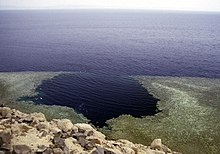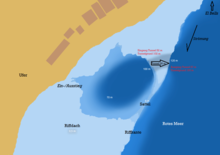Blue Hole (Egypt)
The Blue Hole ( English for 'blue hole') is a hole in the roof of the coastal fringing reef on the Egyptian coast of the Red Sea and a popular diving spot . It is located 10 km north of Dahab on the east coast of the Sinai Peninsula on the Gulf of Aqaba . Due to numerous accidents, the Blue Hole is often referred to as the most dangerous dive site in the world.
General
The Blue Hole is a large hole in the reef roof of the coastal fringing reef , which drops vertically to depths of 70 m to 110 m. It has a diameter of 50 to 65 m. The transition from the Blue Hole to the open Red Sea, known as the saddle, is about 6 m deep.
Inside the Blue Hole there are mostly only dead corals and relatively little other marine life. The water is also mostly cloudy due to the tidal runoff from the reef roof; the average visibility is around 20 to 25 m. Guided diving and snorkeling trips are therefore mainly carried out (with the current) along the steep drop of the outer reef (up to a maximum of 40 m depth), over the saddle and finally flat along the edge of the Blue Hole. The Bells dive site , located about 150 m northeast of the Blue Hole , usually serves as an entry point ; the exit usually takes place in the Blue Hole.
The small bay and the sensitive coral reef are visited by numerous tourists in almost every season; over 1000 tourists a day were reported at weddings. The place is approached by organized jeep trips and by coaches from Sharm El Sheikh , Dahab , Nuwaiba , Taba . This makes the Blue Hole one of the most popular diving and snorkeling spots in the world. Sometimes more people cavort in the water than in a crowded swimming pool. The narrow bank is lined closely with restaurants, the overburdened sanitary facilities of which can hardly cope with the onslaught.
The Arch or Cathedral
The Blue Hole has a connection to the open sea, which is known because of its shape as an arch (English for 'arch') or a cathedral . The passage extends from the bottom of the Blue Hole from about 102 m depth up to about 52 m depth; on the outer reef it extends between approximately 120 m maximum and 57 m minimum depth. At the upper end (at around 55 m depth) the passage is only a few meters wide. The tunnel is around 26 m long. At the outer edge, too, the coral reef forms an almost vertical drop, which continues below the exit of the Blue Hole as a steep slope to a depth of over 250 m.
Diving through the breakthrough from the Blue Hole to the outer reef is considered dangerous. It is not possible without the scuba diving usual depth limits of the dive associations to exceed (30 and 40 meters), and should be in deep diving experienced and technical divers with special breathing gas mixture ( trimix ) and adequate diving equipment to be reserved. Even for experienced divers, diving poses a considerable risk, not least due to incalculable flow conditions (including occasional downward currents). One or more unforeseen problems can then quickly lead to a life-threatening chain of events in connection with the severely limited ability to judge and react at this depth.
Several trained apnea divers dived the Arch without breathing gas with bated breath in around three minutes. The Austrian Herbert Nitsch is said to have succeeded first in 2003 . Furthermore, the Russian Natalja Moltschanowa , the Australian Mike Wells , the French Rémy Dubern , the German Andreas Güldner and the New Zealander William Trubridge (the latter without fins) dived through the breakthrough.
Fatal diving accidents
According to the Egyptian authorities, a total of 130 divers died in the Blue Hole between 1997, the start of the official census, and 2011. It is estimated that around 300 deaths have occurred at this dive site since diving tourism began in the early 1980s. Most of the dead, almost exclusively men and experienced divers, remained missing . The Blue Hole is probably the dive site with the most fatally accidental divers worldwide. Failed divers usually sink to the sloping, sandy bottom; most of the bodies are between 100 and 120 m deep. Rescues are correspondingly complex.
Several memorial plaques for divers who died here have been placed on the rock wall that bounds the bay to the north. Including for Yuri Lipski, who recorded his own death with a video camera in 2000 at the age of 22 years at a depth of 90 meters below the surface of the water.
literature
- Dimitri Ladischensky: The bone collector from the Blue Hole . In: The fatal pleasure in depth. The Blue Hole in the Red Sea is Mount Everest for divers (= Mare . No. 90). February 2012, ISBN 978-3-936543-85-8 , p. 12 ff. ( Text excerpts online ).
- Maik Großekathöfer: In the bone garden . In: Der Spiegel . No. 28 , 2012, p. 104-107 ( online - 9 July 2012 ).
Web links
- Heinz Krimmer: The diving cemetery . Heinz Krimmer's website (interview with Tarek Omar about the Blue Hole).
- Michael Böhm: The most dangerous diving spots in the world - Blue Hole: Blue grave in the Red Sea . In: Focus Online , March 24, 2014.
Individual evidence
- ↑ Dimitri Ladischensky: The bone collector from the Blue Hole . In: Mare , No. 90, February 2012, here p. 17.
- ^ Heinz Krimmer: The diving cemetery . Website of the diving journalist Heinz Krimmer, accessed on August 12, 2017.
Coordinates: 28 ° 34 ′ 20.1 ″ N , 34 ° 32 ′ 13.4 ″ E




